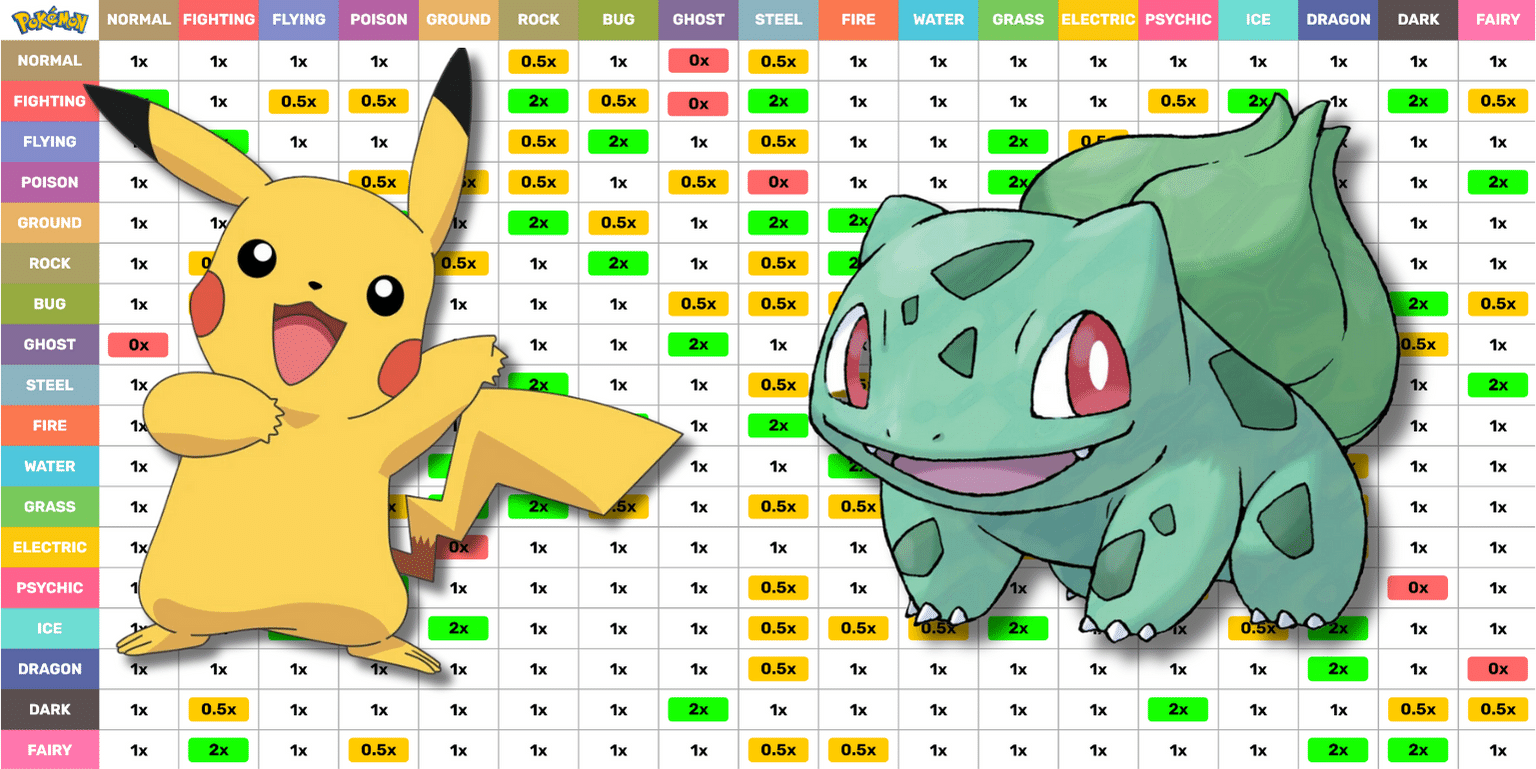Pokemon Types Guide: Strengths and Weaknesses
Pokemon is Basically a Game of Rock Paper Scissors. I made a helpful Nature Chart that you can use to check the Strengths and Weaknesses of Moves

When it comes to your success in Pokémon battles, comprehension of the Pokémon type chart is a crucial element. With a universe of over 1,000 Pokémon, each boasting its unique strengths, weaknesses, and resistances, this task may seem daunting. But don't fret trainer! Whether you're a newcomer dipping your toes into the Pokémon world, or an experienced trainer seeking a refresher, this guide is constructed to succinctly present the essentials of Pokémon types.
Knowing your Pokémon's type and how it matches up against your opponent's can often be the difference between victory and defeat.
What are Pokemon Types
Simply put, Pokémon types are fundamental natures that each Pokémon falls into. The concept of Pokémon types is a pivotal part of the franchise because these types determine a great deal of a Pokémon's strengths and weaknesses in battles. There are 18 different Pokémon types in the series.
- Normal
- Fire
- Water
- Electric
- Grass
- Ice
- Fighting
- Poison
- Ground
- Flying
- Psychic
- Bug
- Rock
- Ghost
- Dragon
- Dark
- Steel
- Fairy
Each type carries its unique advantages and disadvantages against other types, reinforcing the rock-paper-scissors mechanic inherent to the Pokémon battle system.
For example, a Fire-type attack will be highly effective against a Grass-type Pokémon but will be less damaging to a Water-type Pokémon. This interplay of strengths and weaknesses accentuates the strategic elements of Pokémon battles.
The Pokémon Nature Chart
The Pokémon nature type chart is an essential tool in the Pokémon universe, functioning as a comprehensive guide that illustrates how each of the 18 types interacts with one another in battles. By consulting this chart, you are able to predict the potential effectiveness of a move against a target of a specific type, thereby dramatically influencing your battle strategy. The chart can seem overwhelming at first, but with a little bit of practice, you will be able to use it with ease.

On the Pokémon type chart, effectiveness is categorized into four different sections: Normal, Super Effective, Not Very Effective, and Immune. For example, Fire type moves are 'Super Effective' against Grass type Pokémon but are 'Not Very Effective' against Water types. Knowing these relationships between types gives you an edge in battles.
Reading the Pokémon Type Chart
The Pokémon type chart is organized in a grid pattern, making it easy to read. The types are listed both horizontally and vertically:
- The attacker's or move's type is seen on the vertical axis (left),
- The defender's, or target Pokémon's type, appears on the horizontal axis (top).
Then, you simply cross-reference the two types to see how effective the move will be. For instance, if Electric is attacking (on left) and Water is defending (on top), you'd find where they meet on the chart and see that Electric is '2x effective' against Water.
How to Check a Pokémon's Nature in Main Series Games
Understanding a Pokémon's type is a crucial strategy for both battles and team-building in all main series games. Checking a Pokémon's type is relatively straightforward, but different games might have unique ways of providing this information. Here are the generalized steps you can follow:
- Select the Pokémon: From your party, choose the Pokémon whose type you want to check.
- Open Pokémon Summary: This is typically accessed through the "Pokémon" menu option from the main menu. Select "Summary" to view detailed information about the selected Pokémon.
- View Pokémon Type: The summary page displays the Pokémon's type or types at the very top, under or beside the Pokémon's name and level. The types are represented by icons and text, making them easy to identify.
Same-Type Attack Bonus (STAB) Mechanic
Ever wonder why Pikachu's 'Thunder Shock' seems more powerful than it should be? That's likely due to the Same-Type Attack Bonus, or STAB. If you're looking to maximize the damage output in your battles, understanding the concept of the Same-Type Attack Bonus (STAB) is crucial. STAB (Same-Type Attack Bonus) increases the damage output of moves that match a Pokémon's type.
How Does STAB work?
Let's break it down: If a Fire Type Pokémon, like Charizard, utilises a Fire Type move, such as Flamethrower, the damage dealt by that move increases by 50%. In comparison, if Charizard were to use a move of a different Type, like the Steel Type move Metal Claw, no such bonus would apply and the move would deal standard damage.
- Basic Rule: STAB increases the power of an attack by 50% if the move's type matches one of the user's types.
- Note: In relation to the dual types, a Pokémon will get a STAB bonus for moves of either of its two Types. For example, Charizard being a Fire and Flying dual type has this advantage.
STAB in Different Generations
The concept of STAB has been in the Pokémon games since the first generation, though its execution has undergone some changes over the generations. Originally, STAB increased the power of a move by a flat 50%, regardless of any other considerations. But in recent games, certain Abilities, moves, and items can alter the STAB bonus.
STAB and Abilities
Some Pokémon Abilities can augment the power of STAB. For instance, the Ability 'Adaptability' increases the STAB from 1.5x to 2x. This feature adds a layer of strategy into the game, as trainers may opt to select Pokémon Abilities that complement their primary Type to maximize damage output.
Terastalize Mechanic in Pokémon Scarlet and Violet

In the recent addition to the Pokémon series, Pokémon Scarlet and Violet, a new mechanic called Terastalize has been introduced. This mechanic shares some similarities with the well-known same-type attack bonus (STAB), but comes with its unique features and benefits. Let's dive into it in more detail.
What is Terastalize?
Terastalize, reminiscent of Mega Evolution and Dynamax, allows Pokémon to power boost their attacks by infusing their moves with their own type. This means that a Water-type Pokémon, for instance, can Terastalize a Normal-type move into a Water-type move, earning the benefits associated with STAB and catching opponents off guard.
How Does Terastalize Work?
Terastalize works similarly to STAB but with an added twist. Once a Pokémon decides to Terastalize a move, that move will not just gain additional power, but it will also change its type to match that of the user. So, if a Water-type Pokémon Terastalizes a Normal-type move like Hyper Beam, it becomes a Water-Type Hyper Beam and benefits from STAB, making it a surprising and high-powered threat.
Note: remember that Terastalize can only be used once per battle, like Mega Evolution. Lots of thought should go into picking the right moment to use it. Utilizing it at the wrong time could lead to a wasted opportunity.









